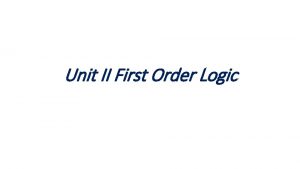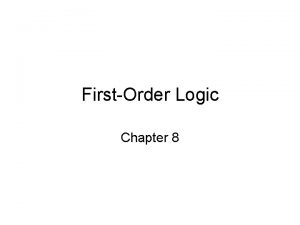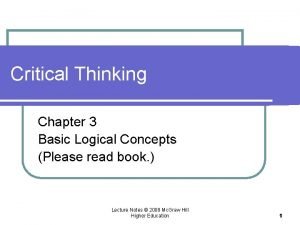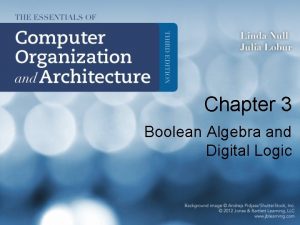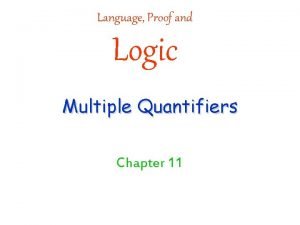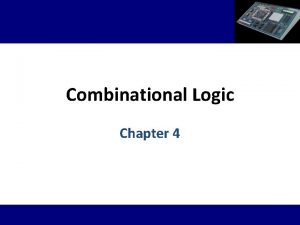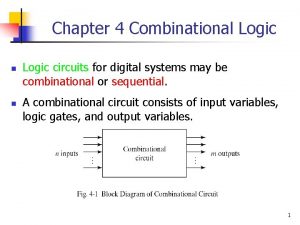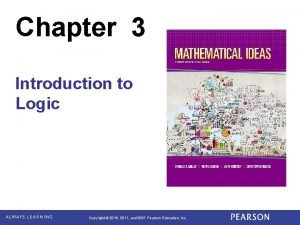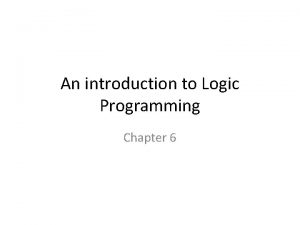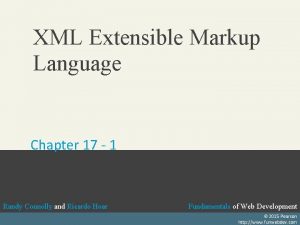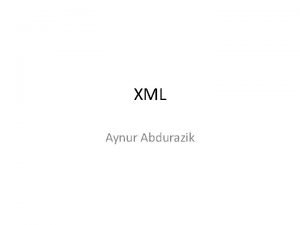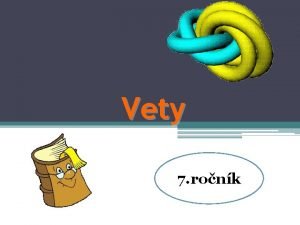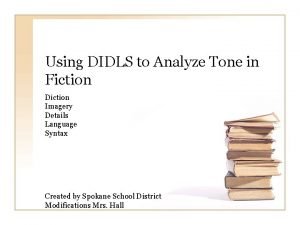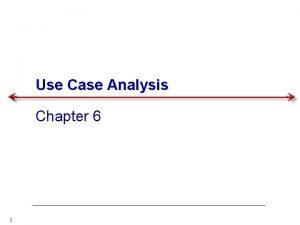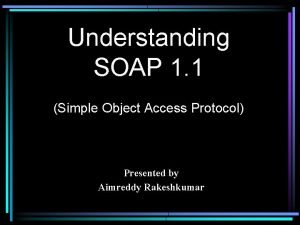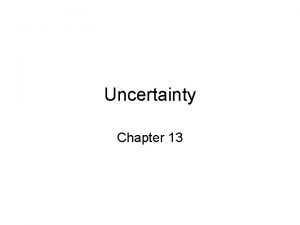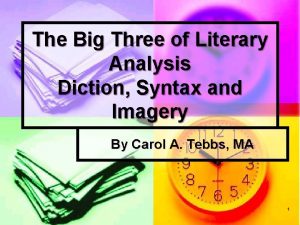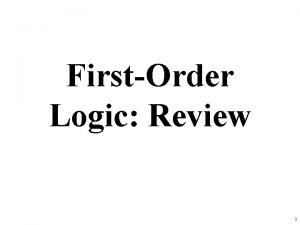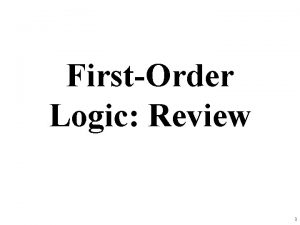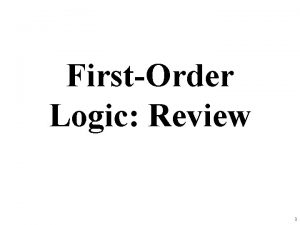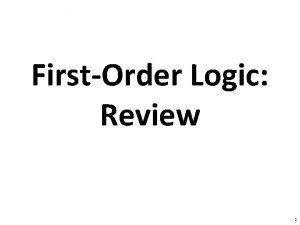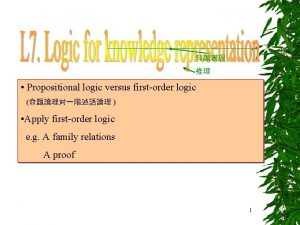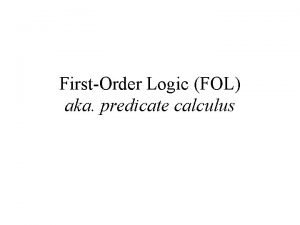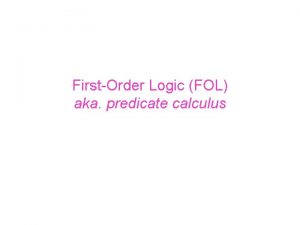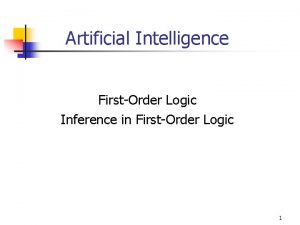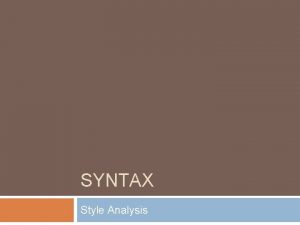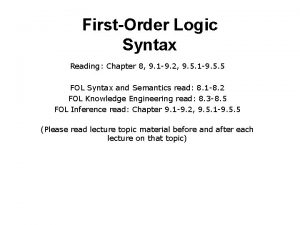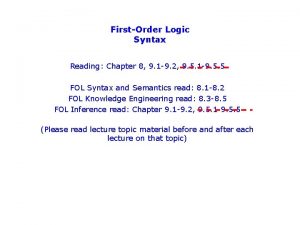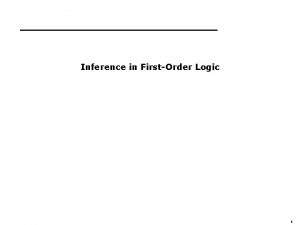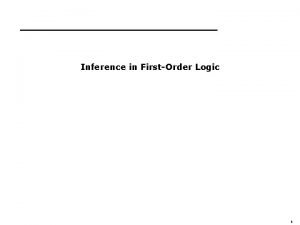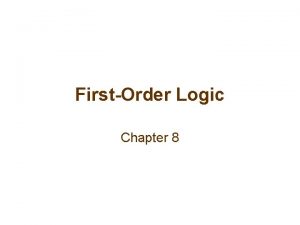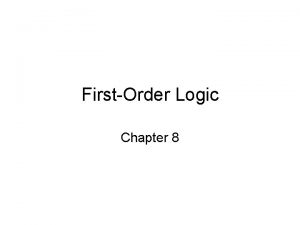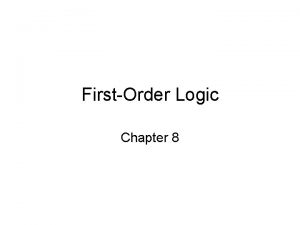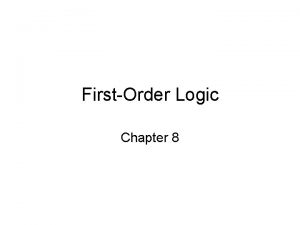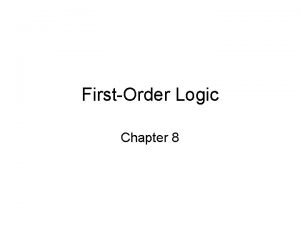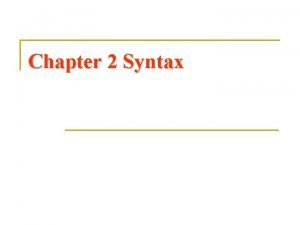FirstOrder Logic Syntax Reading Chapter 8 9 1





































- Slides: 37

First-Order Logic Syntax Reading: Chapter 8, 9. 1 -9. 2, 9. 5. 1 -9. 5. 5 FOL Syntax and Semantics read: 8. 1 -8. 2 FOL Knowledge Engineering read: 8. 3 -8. 5 FOL Inference read: Chapter 9. 1 -9. 2, 9. 5. 1 -9. 5. 5 (Please read lecture topic material before and after each lecture on that topic)

Review: Resolution as Efficient Implication (OR A B C D) ->Same -> (OR ¬A E F G) ->Same -> --------------(OR B C D E F G) (NOT (OR B C D)) => A A => (OR E F G) --------------------------(NOT (OR B C D)) => (OR E F G) --------------------------(OR B C D E F G)

Outline for First-Order Logic (FOL, also called FOPC) • Propositional Logic is Useful --- but has Limited Expressive Power • First Order Predicate Calculus (FOPC), or First Order Logic (FOL). – FOPC has greatly expanded expressive power, though still limited. • New Ontology – The world consists of OBJECTS (for propositional logic, the world was facts). – OBJECTS have PROPERTIES and engage in RELATIONS and FUNCTIONS. • New Syntax – Constants, Predicates, Functions, Properties, Quantifiers. • New Semantics – Meaning of new syntax. • Knowledge engineering in FOL • Inference in FOL

FOL Syntax: You will be expected to know • FOPC syntax – Syntax: Sentences, predicate symbols, function symbols, constant symbols, variables, quantifiers • De Morgan’s rules for quantifiers – connections between and • Nested quantifiers – Difference between “ x y P(x, y)” and “ x y P(x, y)” – x y Likes(x, y) --- “Everybody likes somebody. ” – x y Likes(x, y) --- “Somebody likes everybody. ” • Translate simple English sentences to FOPC and back – x y Likes(x, y) “Everyone has someone that they like. ” – x y Likes(x, y) “There is someone who likes every person. ”

Pros and cons of propositional logic Propositional logic is declarative - Knowledge and inference are separate Propositional logic allows partial/disjunctive/negated information – unlike most programming languages and databases Propositional logic is compositional: – meaning of B 1, 1 P 1, 2 is derived from meaning of B 1, 1 and of P 1, 2 Meaning in propositional logic is context-independent – unlike natural language, where meaning depends on context Propositional logic has limited expressive power – E. g. , cannot say “Pits cause breezes in adjacent squares. “ • except by writing one sentence for each square – Needs to refer to objects in the world, – Needs to express general rules

First-Order Logic (FOL), also called First-Order Predicate Calculus (FOPC) • Propositional logic assumes the world contains facts. • First-order logic (like natural language) assumes the world contains – Objects: people, houses, numbers, colors, baseball games, wars, … – Functions: father of, best friend, one more than, plus, … • Function arguments are objects; function returns an object – Objects generally correspond to English NOUNS – Predicates/Relations/Properties: red, round, prime, brother of, bigger than, part of, comes between, … • Predicate arguments are objects; predicate returns a truth value – Predicates generally correspond to English VERBS • First argument is generally the subject, the second the object • Hit(Bill, Ball) usually means “Bill hit the ball. ” • Likes(Bill, Ice. Cream) usually means “Bill likes Ice. Cream. ” • Verb(Noun 1, Noun 2) usually means “Noun 1 verb noun 2. ”

Aside: First-Order Logic (FOL) vs. Second-Order Logic • First Order Logic (FOL) allows variables and general rules – “First order” because quantified variables represent objects. – “Predicate Calculus” because it quantifies over predicates on objects. • E. g. , “Integral Calculus” quantifies over functions on numbers. • Aside: Second Order logic – “Second order” because quantified variables can also represent predicates and functions. • E. g. , can define “Transitive Relation, ” which is beyond FOPC. • Aside: In FOL we can state that a relationship is transitive – E. g. , Brother. Of is a transitive relationship – x, y, z Brother. Of(x, y) Brother. Of(y, z) => Brother. Of(x, z) • Aside: In Second Order logic we can define “Transitive” – P, x, y, z Transitive(P) ( P(x, y) P(y, z) => P(x, z) ) – Then we can state directly, Transitive(Brother. Of)

FOL (or FOPC) Ontology: What kind of things exist in the world? What do we need to describe and reason about? Objects --- with their relations, functions, predicates, properties, and general rules. Reasoning Representation ---------A Formal Symbol System Syntax ----What is said Semantics ------What it means Inference ----------Formal Pattern Matching Schema ------Rules of Inference Execution ------Search Strategy

Syntax of FOL: Basic elements • Constants King. John, 2, UCI, . . . • Predicates Brother, >, . . . • Functions Sqrt, Left. Leg. Of, . . . • Variables x, y, a, b, . . . • Quantifiers , • Connectives , , (standard) • Equality = (but causes difficulties…. )

Syntax of FOL: Basic syntax elements are symbols • Constant Symbols (correspond to English nouns) – Stand for objects in the world. • E. g. , King. John, 2, UCI, . . . • Predicate Symbols (correspond to English verbs) – Stand for relations (maps a tuple of objects to a truth-value) • E. g. , Brother(Richard, John), greater_than(3, 2), . . . – P(x, y) is usually read as “x is P of y. ” • E. g. , Mother(Ann, Sue) is usually “Ann is Mother of Sue. ” • Function Symbols (correspond to English nouns) – Stand for functions (maps a tuple of objects to an object) • E. g. , Sqrt(3), Left. Leg. Of(John), . . . • Model (world) = set of domain objects, relations, functions • Interpretation maps symbols onto the model (world) – Very many interpretations are possible for each KB and world! – Job of the KB is to rule out models inconsistent with our knowledge.

Syntax : Relations, Predicates, Properties, Functions • Mathematically, all the Relations, Predicates, Properties, and Functions CAN BE represented simply as sets of m-tuples of objects: • Let W be the set of objects in the world. • Let Wm = W x … (m times) … x W – The set of all possible m-tuples of objects from the world • An m-ary Relation is a subset of Wm. – – Example: Let W = {John, Sue, Bill} Then W 2 = {<John, John>, <John, Sue>, …, <Sue, Sue>} E. g. , Married. To = {<John, Sue>, <Sue, John>} E. g. , Father. Of = {<John, Bill>} • Analogous to a constraint in CSPs – The constraint lists the m-tuples that satisfy it. – The relation lists the m-tuples that participate in it.

Syntax : Relations, Predicates, Properties, Functions • A Predicate is a list of m-tuples making the predicate true. – E. g. , Prime. Factor. Of = {<2, 4>, <2, 6>, <3, 6>, <2, 8>, <3, 9>, …} – This is the same as an m-ary Relation. – Predicates (and properties) generally correspond to English verbs. • A Property lists the m-tuples that have the property. – Formally, it is a predicate that is true of tuples having that property. – E. g. , Is. Red = {<Ball-5>, <Toy-7>, <Car-11>, …} – This is the same as an m-ary Relation. • A Function CAN BE represented as an m-ary relation – the first (m-1) objects are the arguments and the mth is the value. – E. g. , Square = {<1, 1>, <2, 4>, <3, 9>, <4, 16>, …} • An Object CAN BE represented as a function of zero arguments that returns the object. – This is just a 1 -ary relationship.

Syntax of FOL: Terms • Term = logical expression that refers to an object • There are two kinds of terms: – Constant Symbols stand for (or name) objects: • E. g. , King. John, 2, UCI, Wumpus, . . . – Function Symbols map tuples of objects to an object: • E. g. , Left. Leg(King. John), Mother(Mary), Sqrt(x) • This is nothing but a complicated kind of name – No “subroutine” call, no “return value”

Syntax of FOL: Atomic Sentences • Atomic Sentences state facts (logical truth values). – An atomic sentence is a Predicate symbol, optionally followed by a parenthesized list of any argument terms – E. g. , Married( Father(Richard), Mother(John) ) – An atomic sentence asserts that some relationship (some predicate) holds among the objects that are its arguments. • An Atomic Sentence is true in a given model if the relation referred to by the predicate symbol holds among the objects (terms) referred to by the arguments.

Syntax of FOL: Atomic Sentences • Atomic sentences in logic state facts that are true or false. • Properties and m-ary relations do just that: Larger. Than(2, 3) is false. Brother. Of(Mary, Pete) is false. Married(Father(Richard), Mother(John)) could be true or false. Properties and m-ary relations are Predicates that are true or false. • Note: Functions refer to objects, do not state facts, and form no sentence: – Brother(Pete) refers to John (his brother) and is neither true nor false. – Plus(2, 3) refers to the number 5 and is neither true nor false. • Brother. Of( Pete, Brother(Pete) ) is True. Binary relation is a truth value. Function refers to John, an object in the world, i. e. , John is Pete’s brother. (Works well iff John is Pete’s only brother. )

Syntax of FOL: Connectives & Complex Sentences • Complex Sentences are formed in the same way, and are formed using the same logical connectives, as we already know from propositional logic • The Logical Connectives: – – – biconditional implication and or negation • Semantics for these logical connectives are the same as we already know from propositional logic.

Complex Sentences • We make complex sentences with connectives (just like in propositional logic). property binary relation function objects connectives

Examples • Brother(Richard, John) Brother(John, Richard) • King(Richard) King(John) • King(John) => King(Richard) • Less. Than(Plus(1, 2) , 4) Greater. Than(1, 2) (Semantics of complex sentences are the same as in propositional logic)

Syntax of FOL: Variables • Variables range over objects in the world. • A variable is like a term because it represents an object. • A variable may be used wherever a term may be used. – Variables may be arguments to functions and predicates. • (A term with NO variables is called a ground term. ) • (A variable not bound by a quantifier is called free. )

Syntax of FOL: Logical Quantifiers • There are two Logical Quantifiers: – Universal: x P(x) means “For all x, P(x). ” • The “upside-down A” reminds you of “ALL. ” – Existential: x P(x) means “There exists x such that, P(x). ” • The “upside-down E” reminds you of “EXISTS. ” • Syntactic “sugar” --- we really only need one quantifier. – x P(x) – You can ALWAYS convert one quantifier to the other. • RULES: and • RULE: To move negation “in” across a quantifier, change the quantifier to “the other quantifier” and negate the predicate on “the other side. ” – x P(x)

Universal Quantification • means “for all” • Allows us to make statements about all objects that have certain properties • Can now state general rules: x King(x) => Person(x) “All kings are persons. ” x Person(x) => Has. Head(x) “Every person has a head. ” i Integer(i) => Integer(plus(i, 1)) “If i is an integer then i+1 is an integer. ” Note that x King(x) Person(x) is not correct! This would imply that all objects x are Kings and are People x King(x) => Person(x) is the correct way to say this Note that => is the natural connective to use with .

Universal Quantification • Universal quantification is equivalent to: – Conjunction of all sentences obtained by substitution of an object for the quantified variable. • All Cats are Mammals. – x Cat(x) Mammal(x) • Conjunction of all sentences obtained by substitution of an object for the quantified variable: Cat(Spot) Mammal(Spot) Cat(Rick) Mammal(Rick) Cat(LAX) Mammal(LAX) Cat(Shayama) Mammal(Shayama) Cat(France) Mammal(France) Cat(Felix) Mammal(Felix) …

Existential Quantification • x means “there exists an x such that…. ” (at least one object x) • Allows us to make statements about some object without naming it • Examples: x King(x) “Some object is a king. ” x Lives_in(John, Castle(x)) “John lives in somebody’s castle. ” i Integer(i) Greater. Than(i, 0) “Some integer is greater than zero. ” Note that is the natural connective to use with (And note that => is the natural connective to use with )

Existential Quantification • Existential quantification is equivalent to: – Disjunction of all sentences obtained by substitution of an object for the quantified variable. • Spot has a sister who is a cat. – x Sister(x, Spot) Cat(x) • Disjunction of all sentences obtained by substitution of an object for the quantified variable: Sister(Spot, Spot) Cat(Spot) Sister(Rick, Spot) Cat(Rick) Sister(LAX, Spot) Cat(LAX) Sister(Shayama, Spot) Cat(Shayama) Sister(France, Spot) Cat(France) Sister(Felix, Spot) Cat(Felix) …

Combining Quantifiers --- Order (Scope) The order of “unlike” quantifiers is important. Like nested variable scopes in a programming language Like nested ANDs and ORs in a logical sentence x y Loves(x, y) – For everyone (“all x”) there is someone (“exists y”) whom they love. – There might be a different y for each x (y is inside the scope of x) y x Loves(x, y) – There is someone (“exists y”) whom everyone loves (“all x”). – Every x loves the same y (x is inside the scope of y) Clearer with parentheses: y( x Loves(x, y) ) The order of “like” quantifiers does not matter. Like nested ANDs and ANDs in a logical sentence x y P(x, y) y x P(x, y)






Connections between Quantifiers • Asserting that all x have property P is the same as asserting that does not exist any x that does not have the property P x Likes(x, CS-171 class) x Likes(x, CS-171 class) • Asserting that there exists an x with property P is the same as asserting that not all x do not have the property P x Likes(x, Ice. Cream) x Likes(x, Ice. Cream) In effect: - is a conjunction over the universe of objects - is a disjunction over the universe of objects Thus, De. Morgan’s rules can be applied

De Morgan’s Law for Quantifiers De Morgan’s Rule Generalized De Morgan’s Rule is simple: if you bring a negation inside a disjunction or a conjunction, always switch between them (or and, and or).

Aside: More syntactic sugar --- uniqueness • ! x is “syntactic sugar” for “There exists a unique x” – “There exists one and only one x” – “There exists exactly one x” – Sometimes ! is written as 1 • For example, ! x President. Of. The. USA(x) – “There is exactly one President. Of. The. USA. ” • This is just syntactic sugar: – ! x P(x) is the same as x P(x) ( y P(y) => (x = y) )

Equality • term 1 = term 2 is true under a given interpretation if and only if term 1 and term 2 refer to the same object • E. g. , definition of Sibling in terms of Parent: x, y Sibling(x, y) [ (x = y) m, f (m = f) Parent(m, x) Parent(f, x) Parent(m, y) Parent(f, y)] Equality can make reasoning much more difficult! (See R&N, section 9. 5. 5, page 353) You may not know when two objects are equal. E. g. , Ancients did not know (Morning. Star = Evening. Star = Venus) You may have to prove x = y before proceeding E. g. , a resolution prover may not know 2+1 is the same as 1+2

Syntactic Ambiguity • FOPC provides many ways to represent the same thing. • E. g. , “Ball-5 is red. ” – Has. Color(Ball-5, Red) • Ball-5 and Red are objects related by Has. Color. – Red(Ball-5) • Red is a unary predicate applied to the Ball-5 object. – Has. Property(Ball-5, Color, Red) • Ball-5, Color, and Red are objects related by Has. Property. – Color. Of(Ball-5) = Red • Ball-5 and Red are objects, and Color. Of() is a function. – Has. Color(Ball-5(), Red()) • Ball-5() and Red() are functions of zero arguments that both return an object, which objects are related by Has. Color. – … • This can GREATLY confuse a pattern-matching reasoner. – Especially if multiple people collaborate to build the KB, and they all have different representational conventions.

Syntactic Ambiguity --- Partial Solution • FOL can be TOO expressive, can offer TOO MANY choices • Likely confusion, especially for teams of Knowledge Engineers • Different team members can make different representation choices – E. g. , represent “Ball 43 is Red. ” as: • a predicate (= verb)? E. g. , “Red(Ball 43)” ? • an object (= noun)? E. g. , “Red = Color(Ball 43))” ? • a property (= adjective)? E. g. , “Has. Property(Ball 43, Red)” ? • PARTIAL SOLUTION: – An upon-agreed ontology that settles these questions – Ontology = what exists in the world & how it is represented – The Knowledge Engineering teams agrees upon an ontology BEFORE they begin encoding knowledge

Summary • First-order logic: – Much more expressive than propositional logic – Allows objects and relations as semantic primitives – Universal and existential quantifiers • Syntax: constants, functions, predicates, equality, quantifiers • Nested quantifiers – Order of unlike quantifiers matters (the outer scopes the inner) • Like nested ANDs and ORs – Order of like quantifiers does not matter • like nested ANDS and ANDs • Translate simple English sentences to FOPC and back
 Syntax directed definition and syntax directed translation
Syntax directed definition and syntax directed translation Pre reading while reading and post reading activities
Pre reading while reading and post reading activities First order logic syntax
First order logic syntax Syntax of first order logic
Syntax of first order logic First order logic vs propositional logic
First order logic vs propositional logic First order logic vs propositional logic
First order logic vs propositional logic Third order logic
Third order logic Combinational vs sequential logic
Combinational vs sequential logic Cryptarithmetic problem logic+logic=prolog
Cryptarithmetic problem logic+logic=prolog Software development plan
Software development plan Is it x y or y x
Is it x y or y x Combinational logic sequential logic 차이
Combinational logic sequential logic 차이 Combinational logic sequential logic
Combinational logic sequential logic St. louis
St. louis Aims and objectives of reading
Aims and objectives of reading The types of reading
The types of reading What is shared reading
What is shared reading Why is critical reading an active process of discovery
Why is critical reading an active process of discovery What is extensive reading
What is extensive reading For adult
For adult How to develop reading skills in students
How to develop reading skills in students Creative thinking
Creative thinking Critical thinking chapter 3
Critical thinking chapter 3 Logic chapter three
Logic chapter three Language proof and logic solutions chapter 11
Language proof and logic solutions chapter 11 Logic chapter four
Logic chapter four 2-to-1 multiplexer
2-to-1 multiplexer Logic chapter 3
Logic chapter 3 Logic chapter 6
Logic chapter 6 Xml usage
Xml usage Dtd syntax
Dtd syntax Oznamovacia veta
Oznamovacia veta Language didls
Language didls Use case syntax
Use case syntax Simple object access protocol
Simple object access protocol Probability syntax
Probability syntax Probability syntax
Probability syntax Syntax and diction
Syntax and diction


